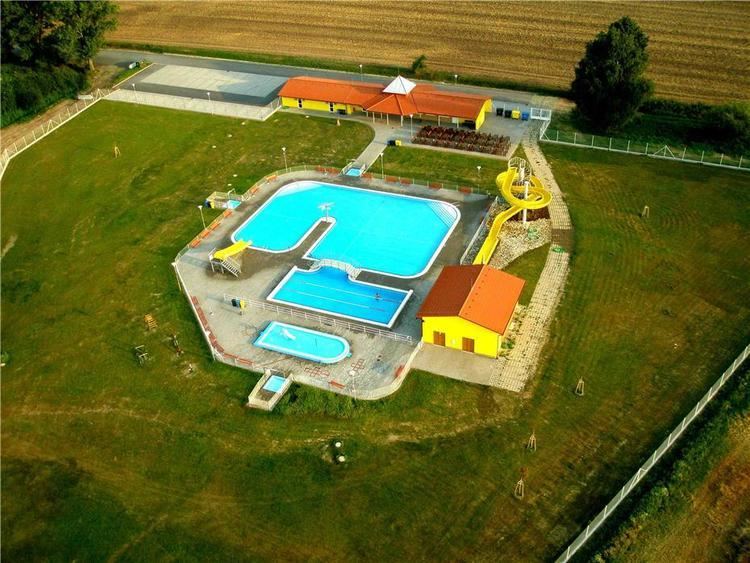Time zone CET (UTC+1) Area 25.93 km² Local time Sunday 1:55 AM | First mentioned 1308 Elevation 376 m Population 3,864 (1 Jan 2015) | |
 | ||
Component settlements ListVelké OpatoviceBezděčíBrťov u Velkých OpatovicKorbelova LhotaSvárovVelká Roudka Weather 13°C, Wind S at 19 km/h, 55% Humidity Points of interest Velké Opatovice, Moravské kartografické centrum, výklenková kaplička sv. Rozálie | ||
Venkov m j domov aneb v kde ije velk opatovice
Velké Opatovice is a small town and a commune in the Moravian region of the Czech Republic.
Contents
- Venkov m j domov aneb v kde ije velk opatovice
- Map of VelkC3A9 Opatovice Czechia
- Dji osmo x3 velk opatovice
- History
- Castle
- Church of St George
- Cartographic centre
- Smolensk reservoir
- Opatovick hradisko
- Facilities culture and sport
- Events
- Industry and employment
- References
Map of Velk%C3%A9 Opatovice, Czechia
Velké Opatovice is situated in Blansko District, about 260 km southeast of Prague and 120 km north of Vinna. The neighboring villages Bezďečí, Brťov, Korbelova Lhota, Svárov, and Velká Roudka are also part of the commune. The city of Boskovice also stands nearby.
Dji osmo x3 velk opatovice
History
The first evidence of the settlement dates to 1308, when a contract shows the purchase of a town called Opatovice by the nearby Cimburk castle, today a ruin. The 'Velké' part of the name (meaning "great") was added in 1888, and the town became a city in 1969. The most significant estates in Velké Opatovice are those of the Vězník, Salm, and Herberštein families.
Castle
The city's baroque castle dates to 1757. It belonged to the Salm family, and passed to the Herbersteins in the late 18th century. The Herbersteins added the castle's neobaroque tower. The castle passed to municipal control after 1945, and it was damaged by a fire that destroyed one block in 1978. The castle now serves as the town museum, with a memorial hall devoted to academic sculptor Carl Otáhal who lived in Velké Opatovice for 30 years. In 2007, the burnt part of the building was replaced with an elliptical auditorium. The castles grounds include beautiful parkland containing plant and animal species and a statue of Bedřich Smetana.
Church of St. George
The city's major church is of interest for its baroque decoration and altar relief of St. George fighting the dragon. The church was built in the late 18th century on the site of a 14th-century Gothic temple.
Cartographic centre
The centre hosts a permanent exhibition on the historical development of cartography. Subjects include the philosophy entailed in imagery of the Earth's surface on maps, and the history of the production of maps. The main auditorium displays a giant relief-map of historical Moravia and Silesia.
Smolenská reservoir
Two km north of the city is Smolenska reservoir, which can be used as a bathing lake. The surrounding countryside is also used for hiking, cycling, and skiing in winter.
Opatovické hradisko
1.5 km south of the city stand the remnants of a 513m tall Bronze Age building. In the rockface below the sculptor Karel Otáhal inscribed relief texts by the poet Petr Bezruč and the composer J.B. Foerst.
At nearby Velká Roudka is the Františkův spring, which produces drinkable water, and the remainder of an abandoned spa founded in 1839.
In Svárov, near this village, is a rock formation called the "stone wedding." Local legend holds that the standing stones there are petrified guests from a wedding, cursed by the chef who was making the wedding dinner and was angry that they were late.
The village is close to the Moravian karst area north of Brno, a limestone nature reserve containing around 400 caves, several open for public exploration. The region's Punkva underground river and 140 metre-deep Macocha abyss are also tourist attractions.
Nearby Castle Bouzov is a 14th-century building largely reconstructed in the romantic style is often used for movie filming.
Facilities, culture, and sport
The town is served by several restaurants and around nine pubs. Nearby Jevíčko houses at least two hotels; the city of Boskovice has further entertainment venues. Public transport is provided by buses. Also within the castle grounds is the town cinema, open on Fridays. A community centre in the centre of the town hosts balls, meetings, tourism events, and dances.
As well as the town museum located in the castle, Velké Opatovice has a gallery devoted to sculptor Karel Otáhal, the creator of a lifesize statue of Smetana located in the castle grounds. The gallery displays over 40 of his busts and many drawings.
A football field hosts matches every Sunday. The town's team holds an annual friendly football match against a team from Croatia, and a local factory has an annual friendly against a company from Germany and the Netherlands. Other facilities include tennis courts and the school sports hall, and women's aerobic classes are held at the community centre.
Events
The city's major annual event is a summer jazz festival held each July, hosting Czech and international bands. July also sees the firemen's beer festival, a weekend-long programme of food, drink, and music. St George's Fair is celebrated on April 27, featuring fairground attractions, music at the community centre, family gatherings, and traditional dress.
Industry and employment
German company P-D Refractories, a producer of refractory products and raw materials, operates a large factory employing many residents of the Velké Opatovice area. The factory produces fireclay bricks, high-alumina bricks, and insulating bricks. The mining industry in nearby Březinka employs more than 1,000 people and is headquartered in Germany. Many other residents are self-employed or work in small businesses including the local butchers, florists, sweetshop, and construction company.
